
Pietro Perugino, born Pietro Vannucci, was an Italian Renaissance painter of the Umbrian school, who developed some of the qualities that found classic expression in the High Renaissance. Raphael was his most famous pupil.

Florentine painting or the Florentine School refers to artists in, from, or influenced by the naturalistic style developed in Florence in the 14th century, largely through the efforts of Giotto di Bondone, and in the 15th century the leading school of Western painting. Some of the best known painters of the earlier Florentine School are Fra Angelico, Botticelli, Filippo Lippi, the Ghirlandaio family, Masolino, and Masaccio.
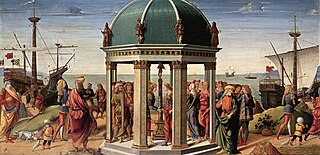
Biagio d’Antonio Tucci was an Italian Renaissance painter active in Florence, Faenza and Rome.

The Marriage of the Virgin, also known as Lo Sposalizio, is an oil painting by the Italian High Renaissance artist Raphael. Completed in 1504 for the Franciscan church of San Francesco, Città di Castello, the painting depicts a marriage ceremony between Mary and Joseph. It changed hands several times before settling in 1806 at the Pinacoteca di Brera.
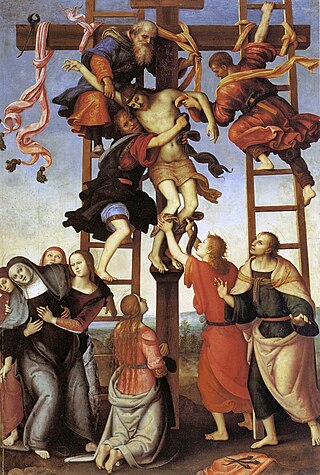
The Annunziata Polyptych is a painting cycle started by Filippino Lippi and finished by Pietro Perugino, whose central panel is now divided between the Galleria dell'Accademia and the Basilica dell'Annunziata, both in Florence, Italy. The polyptych had other six panels, which are housed in the Lindenau-Museum of Altenburg, the Metropolitan Museum of New York City, the Galleria Nazionale d'Arte Antica in Rome and in a private collection in South Africa.

The Adoration of the Magi is a painting by the Italian Renaissance painter Pietro Perugino, housed in the Galleria Nazionale dell'Umbria of Perugia, Italy.

The Lamentation over the Dead Christ is a painting of the common subject of the Lamentation of Christ by the Italian Renaissance painter Pietro Perugino, executed in 1495 and now in the Galleria Palatina of Palazzo Pitti, Florence, Italy.

The Albani Torlonia Altarpiece is a painting by the Italian Renaissance painter Pietro Perugino, executed in 1491 and housed in the Torlonia Collection, Rome. It was commissioned by Cardinal Giuliano della Rovere, the future pope Julius II.
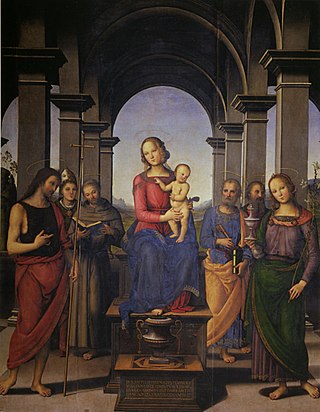
The Fano Altarpiece is a painting by the Italian Renaissance artist Pietro Perugino, executed in 1497, and housed in the church of Santa Maria Nuova, Fano, central Italy. It also includes a lunette with a Pietà and several predella panels.
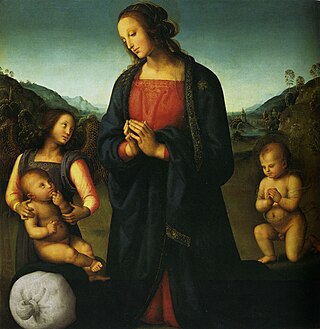
Madonna del Sacco is an oil on panel painting by Perugino, dating to around 1495–1500. It shows the Madonna and Child with the infant John the Baptist and an angel. It is now in the Galleria Palatina in Florence.

The Sant'Agostino Altarpiece is a painting by Perugino, produced in two stages between around 1502 and 1512 and then around 1513 to 1523. The altarpiece's 28, 29 or 30 panels were split up during the Napoleonic suppression of religious houses - most of its panels are now in the Galleria Nazionale dell'Umbria in Perugia. It is notable as the painter's last masterwork before he moved into his late phase producing more provincial commissions.

Madonna della Consolazione is an oil on panel painting by Perugino, datable ca. around 1496–1498. The work, completed in April 1498, was carried out in the Sala delle Udienze of the Collegio del Cambio. Since c. 1820 it is preserved in the National Gallery of Umbria in Perugia.

Crucifixion is a painting of the Crucifixion of Christ, usually attributed to Perugino, with or without assistance from Luca Signorelli. The work's dating and attribution are both uncertain - Venturi and Schmarsow attribute it to a pupil of Perugino, whilst other art historians attribute it to Perugino alone or with assistance from Signorelli. The deep chiaroscuro is comparable to Signorelli's style elsewhere or to the early style of Perugino whilst he was still heavily influenced by Verrochio. The landscape background is typical of Perugino, with mountains and hills in deep perspective.

The Crucifixion with Mary Magdalene is a fresco of c. 1495 of the Crucifixion of Christ by Perugino in the chapter house of the Cistercian monastery of Santa Maria Maddalena dei Pazzi in Florence. It is his most notable work in Florence. It was a commission from the Pucci family - Antonio Billi's account book reports Dionigi and Giovanna Pucci commissioning a work from "Master Piero della Pieve a Chastello, a Perugian" on 20 November 1493 and paying 55 gold ducats on its completion on 20 April 1496.

Miracle of the Snow is a painting in tempera on panel by Pietro Perugino, dating to around 1472–1474 and now in the collection of Polesden Lacey. It shows the miraculous fall of snow which marked the spot for the foundation of Santa Maria Maggiore in Rome in 352. The painting belongs to Perugino's early period and the important commissions he gained during the short time he was active in Florence. Both it and the Nativity of the Virgin are usually identified as one of two surviving parts of the same predella, either from a lost altarpiece of the Virgin Mary or from the Pala di San Martino a Strada by Andrea del Verrocchio's studio. Both predella panels were in the Pucci chapel in Santissima Annunziata in Florence by 1786, when they were bought by John Campbell. They were sold to different owners in London in 1804, with the Miracle entering the Polesden Lacey collection.

Mary Magdalene is an oil on panel painting of Mary Magdalene, dating to around 1500 and now in the Galleria Palatina in Florence - it has featured in its inventory since 1641. It is now attributed to Perugino. It is modelled on his wife Chiara Fancelli, who also modelled for several of his Madonnas. It is comparable to his Madonna and Child with St John the Baptist and St Catherine of Alexandria (Louvre), of similar date and with a similar dark background.

The Monteripido Altarpiece is a double-sided altarpiece by Perugino, completed in 1502 for San Francesco al Monte church in Monteripido near Perugia. It is now in the Galleria Nazionale dell'Umbria in Perugia.
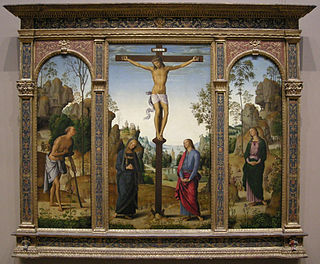
The Galitzin Triptych is a c.1485 painting by Perugino, now in the National Gallery of Art in Washington.
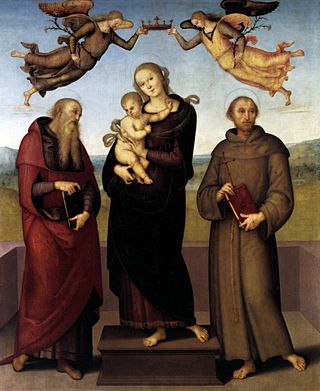
The Madonna of Loreto is a c.1507 oil on panel painting by Perugino, now in the National Gallery, London, which bought it in 1879. It shows the Madonna and Child flanked by Jerome (left) and Francis of Assisi (right). Two angels hover over Mary's head holding a crown. It reuses the low parapet from Madonna and Child with St Rose and St Catherine (1492) and probably also involved the master's studio assistants.
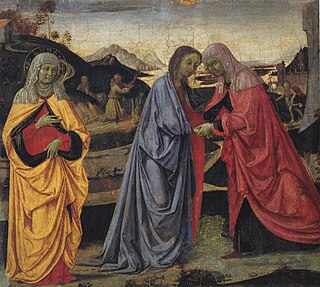
Visitation is a tempera on panel painting usually attributed to Perugino, executed c. 1472–1473, now in the Galleria dell'Accademia in Florence. An early work by the artist from around the same time as Nativity of the Virgin, whilst he was still heavily influenced by Andrea del Verrocchio, it probably originated as part of the predella for a lost altarpiece. It shows the Visitation, with the Virgin Mary's mother Saint Anne to the left. In the left background is Francis of Assisi receiving the stigmata and in the right background is Florence's patron saint John the Baptist - this may indicate that the lost altarpiece was intended for a Franciscan monastery in Florence such as Santa Croce.




















